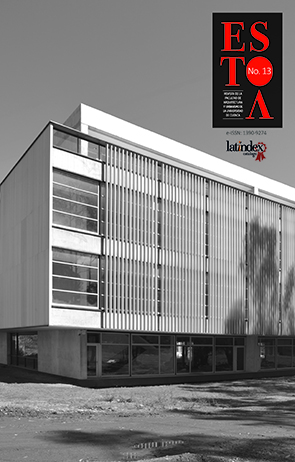Architecture and death: the shower as device
DOI:
https://doi.org/10.18537/est.v007.n013.a09Keywords:
Shower, gas chamber, prison, Nevada, FoucaultAbstract
The shower takes an important position within enclosing architecture. As a system, it is spread in penitentiaries in two forms, the gas chamber and the collective shower, becoming an architectonic device where domination is justified as a moral value. The technology process occurs in three stages: in the 18th and 19th centuries, chemical engineering development allows the way to create artificial precise substances, as well as discovering the pharmakon properties of carbonated gas; through the 19th and the 20th centuries, the prison turns from the domestic model to the panoptic form, while pretending to remove suffer in the process of death penalty, using gas chambers; finally, in the First World War the first massive gas attacks take place, and in the Second World War, the gas chamber and the collective showers get together in a single project, the nazi gas chamber.
Downloads
References
Benjamin, W. (2003). La obra de arte en la época de su reproductibilidad técnica. México DF, México: Ítaca.
Butler, J. (2016). Mecanismos psíquicos del poder. Madrid, España: Cátedra.
Chamaillard, Dr. (1932). L’emploi de l’acide cyanhydrique pour la dératisation. En: G. Petit (Ed.) Deuxième Conférence internationale et congrès colonial du rat et de la peste. Paris, 7-12 octobre 1931. Paris, Francia: Vigot.
Derrida, J. (1997). La diseminación. Madrid, España: Espiral.
Fischer, K. P. (1998). The History of an obsession: German Judeophobia and the Holocaust. New York, EEUU: Continuum.
France, B.O.O.N.H.S. (1942). Bulletin officiel de l'Office national d'hygiène sociale. Tome IV, 1901-1910. Paris, Francia: Impr. Nationale.
France, Office Nationale de la Propriété Industrielle. (1827). Description des Machines et procédés spécifiés dans les brevets d'invention, de perfectionnement et d'importation dont la durée est expirée. Tome XIII. Paris, Francia: Huzard.
Foucault, M. (1975). Surveiller et punir, naissance de la prison. Paris, Francia: Gallimard.
Foucault, M. (1977). Le jeu de Michel Foucault. En: (2001) Dits et écrits II. 1976-1988. Paris, Francia: Gallimard.
Foucault, M. (1980). Power/Knowledge: Selected Interviews and Other Writings, 1972-1997. New York, EEUU: Pantheon.
Foucault, M. (1984). Histoire de la sexualité III. Le souci de soi. Paris, Francia: Gallimard.
Foucault, M. (2000). Un diálogo sobre el poder y otras conversaciones. Madrid, España: Alianza.
Foucault, M. (2007). Los anormales. Curso en el Collège de France (1974-75). Buenos Aires, Argentina: SEE.
Fredet, G. E. (1880). Note sur les effets du gaz acide carbonique à Royat envisagés au point de vue physiologique et thérapeutique. Paris, Francia: Germer-Baillière.
Herpin, J. Ch. (1855). Études médicales, scientifiques et statistiques sur les principales sources d'eaux minérales de France, d'Angleterre et d'Allemagne. Paris, Francia: Baillière.
Lalouette, P. (1776). Nouvelle méthode de traiter les maladies vénériennes, par la fumigation. Paris, Francia: Merigot.
Laville de Laplaigne, A. E. (1824). Mémoire sur les eaux minérales, douches et bains minéraux artificiels et sur les bains et douches de vapeur. Paris, Francia: Gabon.
Müller, F. (1981). Trois ans dans une chambre à gaz d’Auschwitz. Paris, Francia: Pygmalion.
Pressac, J. C. (1989). Auschwitz: Technique and operation of the gas chambers. New York, EEUU: Beate Klarsfeld.
Sloterdijk, P. (2006). Esferas III. Espumas. Madrid, España: Siruela.
Vázquez Astorga, M. (2012). Proyectos de cárceles para los partidos judiciales de la provincia de Zaragoza en el siglo XIX. Boletín del Museo e Instituto Camón Aznar, (110), 309-353.
Villatoro, M. (18.08.2015). La gran mentira nazi para ocultar la masacre de millones de judíos. ABC.
VVAA. (2012). Images of America. Nevada State Prison. Charleston, EEUU: Arcadia.
Wellers, G. (1981). Les chambres à gaz ont existé. Des documents, des témoignages, des chiffres. Paris, Francia: Gallimard.
Published
How to Cite
Issue
Section
License
The Journal declines any responsibility for possible conflicts derived from the authorship of the works that are published in it.
The University of Cuenca in Ecuador conserves the patrimonial rights (copyright) of the published works and will favor the reuse of the same ones, these can be: copy, use, diffuse, transmit and expose publicly.
Unless otherwise indicated, all contents of the electronic edition are distributed under a Creative Commons Attribution-NonCommercial-ShareAlike 4.0 International License.




